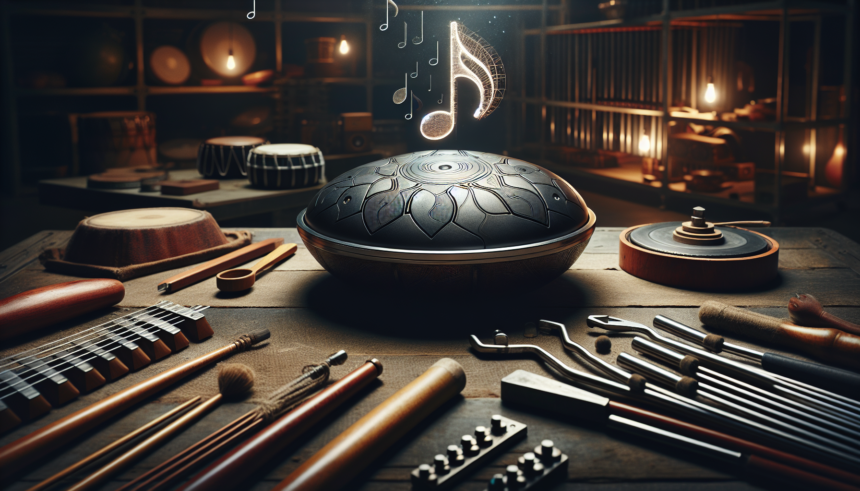The handpan is a beautifully crafted musical instrument known for its ethereal sound and unique design. Originating from the Hang Drum, it has garnered a dedicated following among musicians and enthusiasts alike. One of the key aspects of the handpan is its tuning, which significantly affects the quality of sound it produces. Fine-tuning your handpan is both an art and a science, requiring a keen ear, technical skill, and an understanding of the instrument’s construction. This article delves into the intricacies of handpan tuning, offering guidance on how to achieve optimal sound.
Understanding the Basics of Handpan Tuning
Before diving into the tuning process, it’s essential to understand the structure of a handpan. The handpan consists of two hemispheres of steel, with the top shell featuring a series of indentations or ‘notes’. Each note area is carefully shaped and tuned to produce a specific pitch. The overall sound of the handpan is a harmonious blend of these individual notes, along with the instrument’s fundamental resonance.
The Importance of Accurate Tuning
Accurate tuning is vital for achieving the handpan’s signature sound. Even slight deviations from the intended pitch can create dissonance, affecting the overall musical quality. Moreover, a well-tuned handpan allows for more expressive and precise playing, as each note responds predictably to the player’s touch.
Tools Needed for Tuning
- Tuning Forks: These provide a reference pitch for adjusting the notes.
- Electronic Tuners: Modern tuners can accurately measure pitch changes.
- Hammers: Specially designed hammers are used to shape the steel and adjust pitch.
- Anvils: Small anvils can help in reshaping the metal precisely.
The Step-by-Step Tuning Process
Tuning your handpan involves several steps that must be followed carefully to achieve optimal results. Here is a detailed guide:
1. Initial Assessment
Begin by assessing the current state of your handpan’s tuning. Strike each note and listen carefully to its pitch and tonal quality. Use a tuning fork or electronic tuner to measure the pitch of each note. Note down any discrepancies between the actual pitch and the desired pitch.
2. Identifying Problematic Notes
Identifying notes that are out of tune or have undesirable overtones is crucial. Pay special attention to notes that sound particularly ‘off’ or dissonant. These will be your focus areas during the tuning process.
3. Shaping the Notes
Using a small hammer and anvil, carefully reshape the problematic notes. This process involves subtle adjustments to the profile of the steel around each note area. Striking the steel in certain ways can increase or decrease the pitch. Work slowly and methodically, frequently checking the pitch using a tuner.
4. Fine-Tuning for Harmonics
Each note on the handpan has its fundamental pitch along with several overtones or harmonics. Fine-tuning involves adjusting these harmonics to achieve a balanced and pleasing sound. Pay attention to the secondary and tertiary harmonics, ensuring they are in harmony with the fundamental pitch.
5. Regular Maintenance
Handpans require regular maintenance to retain their optimal sound. Factors such as temperature changes, humidity, and playing intensity can affect the tuning over time. Regularly check the pitch of each note and make minor adjustments as needed to keep your handpan sounding its best.
Advanced Tuning Techniques
For those looking to delve deeper into the tuning process, several advanced techniques can further refine the sound of your handpan.
Thermal Tuning
Thermal tuning involves using controlled heat to adjust the tension and properties of the steel. This technique requires a precise and careful approach, as too much heat can damage the instrument. However, when done correctly, thermal tuning can achieve exceptionally accurate pitch adjustments.
Acoustic Analysis
Utilizing software and acoustic analysis tools can provide a detailed understanding of the handpan’s sound profile. By analyzing the sound waves and frequencies produced by each note, you can make more informed adjustments to the tuning. This method combines the art of listening with the precision of technological analysis.
Common Tuning Challenges
Several common challenges can arise during the tuning process. Understanding these issues can help you troubleshoot and address them effectively.
1. Reactive Steel
Handpans are made from reactive steel that can change its properties with temperature and humidity. These changes can affect the tuning and tonal quality. To mitigate this, always tune your handpan in a stable environment and avoid exposing it to extreme conditions.
2. Over-Tuning
Over-tuning occurs when excessive adjustments are made, leading to a brittle or ‘over-stretched’ sound. This is often a result of inexperienced tuning or an overzealous approach. The key is to make small, incremental adjustments and listen carefully at each step.
3. Sympathetic Vibrations
Sympathetic vibrations occur when one note unintentionally affects another, causing unwanted resonances. This can be particularly challenging to address. Careful attention to the shape and tension of each note area can help minimize these interactions.
The Role of a Professional Tuner
For many handpan players, seeking the expertise of a professional tuner is a valuable investment. Professional tuners have the experience, tools, and technical skill to fine-tune handpans to an exceptionally high standard. Regularly consulting with a professional can ensure your handpan remains in optimal condition, producing the best possible sound.
Conclusion
Fine-tuning a handpan is a meticulous and rewarding process that significantly enhances the instrument’s sound quality. By understanding the basics of tuning, utilizing proper tools, and employing advanced techniques, you can achieve a beautifully harmonious and resonant handpan. Whether you choose to tune your handpan yourself or seek the help of a professional, the effort invested in maintaining optimal tuning will be well worth it, allowing you to fully express the magical music of this unique instrument.
FAQs
1. How often should I tune my handpan?
The frequency of tuning depends on factors such as how often you play, environmental conditions, and the specific characteristics of your handpan. Regular checks every few months are recommended, with professional tuning every 1-2 years.
2. Can I use any hammer for tuning my handpan?
No, it’s important to use specially designed hammers for handpan tuning. These hammers have specific shapes and weights to allow for precise adjustments without damaging the instrument.
3. Is it possible to retune a handpan to a different scale?
Retuning a handpan to a different scale is complex and may not always be feasible due to the specific structure and tuning of the notes. It’s best to consult a professional tuner for advice on this matter.
4. What should I do if my handpan sounds ‘off’ after travel?
Travel can affect the tuning due to temperature and pressure changes. Allow your handpan to acclimate to its new environment for a day or two before checking the tuning and making necessary adjustments.
5. Can I tune my handpan by ear alone?
While experienced tuners may be able to tune by ear, using mechanical aids such as tuning forks and electronic tuners offers greater precision. Combining both listening and technology often yields the best results.





